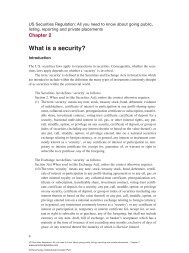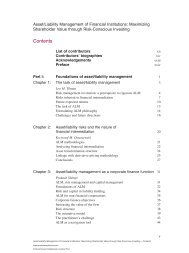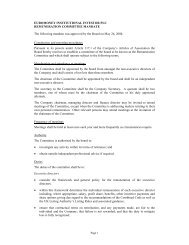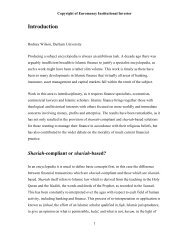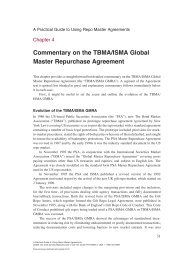Annual Report & Accounts 2012 - Euromoney Institutional Investor ...
Annual Report & Accounts 2012 - Euromoney Institutional Investor ...
Annual Report & Accounts 2012 - Euromoney Institutional Investor ...
You also want an ePaper? Increase the reach of your titles
YUMPU automatically turns print PDFs into web optimized ePapers that Google loves.
<strong>Euromoney</strong> <strong>Institutional</strong> <strong>Investor</strong> PLC <strong>Annual</strong> <strong>Report</strong> and <strong>Accounts</strong> <strong>2012</strong><br />
www.euromoneyplc.com<br />
Notes to the Consolidated<br />
Financial Statements continued<br />
2 Key judgemental areas adopted in preparing these<br />
financial statements continued<br />
Goodwill<br />
Goodwill is impaired where the carrying value of goodwill is higher than<br />
the net present value of future cash flows of those cash generating units to<br />
which it relates. Key areas of judgement in calculating the net present value<br />
are the forecast cash flows, the long-term growth rate of the applicable<br />
businesses and the discount rate applied to those cash flows. Goodwill<br />
held on the Statement of Financial Position at September 30 <strong>2012</strong> was<br />
£333.1 million (2011: £336.6 million).<br />
Deferred consideration<br />
The group often pays for a portion of the equity acquired at a future date.<br />
This deferred consideration is contingent on the future results of the entity<br />
acquired and applicable payment multipliers dependent on those results.<br />
The initial amount of the deferred consideration is recognised as a liability<br />
in the Statement of Financial Position. Each period end management<br />
reassess the amount expected to be paid and any changes to the initial<br />
amount are recognised as a finance income or expense in the Income<br />
Statement. Significant management judgement is required to determine<br />
the amount of deferred consideration that is likely to be paid, particularly<br />
in relation to the future profitability of the acquired business.<br />
Acquisition option commitments<br />
The group is party to a number of put and call options over the remaining<br />
non-controlling interests in some of its subsidiaries. IAS 39 ‘Financial<br />
Instruments: Recognition and Measurement’ requires the discounted<br />
present value of these acquisition option commitments to be recognised<br />
as a liability on the Statement of Financial Position with a corresponding<br />
decrease in reserves. The discounts are unwound as a notional interest<br />
charge to the Income Statement. Key areas of judgement in calculating<br />
the discounted present value of the options are the expected future cash<br />
flows and earnings of the business, the period remaining until the option<br />
is exercised and the discount rate. At September 30 <strong>2012</strong> the discounted<br />
present value of these acquisition option commitments was £7.9 million<br />
(2011: £11.0 million).<br />
Share-based payments<br />
The group makes long-term incentive payments to certain employees.<br />
These payments are measured at their estimated fair value at the date of<br />
grant, calculated using an appropriate option pricing model. The fair value<br />
determined at the grant date is expensed on a straight-line basis over the<br />
expected vesting period, based on the estimate of the number of shares<br />
that will eventually vest. The key assumptions used in calculating the fair<br />
value of the options are the discount rate, the group’s share price volatility,<br />
dividend yield, risk free rate of return, and expected option lives.<br />
These assumptions are set out in note 24. Management regularly perform<br />
a true-up of the estimate of the number of shares that are expected to<br />
vest, which is dependent on the anticipated number of leavers.<br />
The directors regularly reassess the expected vesting period. A plan that<br />
vests earlier than originally estimated results in an acceleration of the fair<br />
value expense of the plan recognised in the Income Statement at the time<br />
the reassessment occurs. Equally, a plan that vests later than previously<br />
estimated results in a credit to the Income Statement at the date of<br />
reassessment.<br />
The charge for long-term incentive payments for the year ended<br />
September 30 <strong>2012</strong> is £6.3 million (2011: £16.1 million).<br />
Defined benefit pension scheme<br />
The surplus or deficit in the defined benefit pension scheme that is<br />
recognised through the Statement of Comprehensive Income is subject<br />
to a number of assumptions and uncertainties. The calculated liabilities of<br />
the scheme are based on assumptions regarding salary increases, inflation<br />
rates, discount rates, the long-term expected return on the scheme’s assets<br />
and member longevity. Details of the assumptions used are shown in note<br />
27. Such assumptions are based on actuarial advice and are benchmarked<br />
against similar pension schemes.<br />
Taxation<br />
The group’s tax charge on ordinary activities is the sum of the total<br />
current and deferred tax charges. The calculation of the group’s total<br />
tax charge necessarily involves a degree of estimation and judgement in<br />
respect of certain items whose tax treatment cannot be finally determined<br />
until resolution has been reached with the relevant tax authority or, as<br />
appropriate, through a formal legal process. The final resolution of some<br />
of these items may give rise to material profit and loss and/or cash flow<br />
variances.<br />
The group is a multi-national group with tax affairs in many geographical<br />
locations. This inherently leads to a higher than usual complexity to the<br />
group’s tax structure and makes the degree of estimation and judgement<br />
more challenging. The resolution of issues is not always within the control<br />
of the group and it is often dependent on the efficiency of the legislative<br />
processes in the relevant taxing jurisdictions in which the group operates.<br />
Issues can, and often do, take many years to resolve. Payments in respect<br />
of tax liabilities for an accounting period result from payments on account<br />
and on the final resolution of open items. As a result, there can be<br />
substantial differences between the tax charge in the Income Statement<br />
and tax payments.<br />
70







